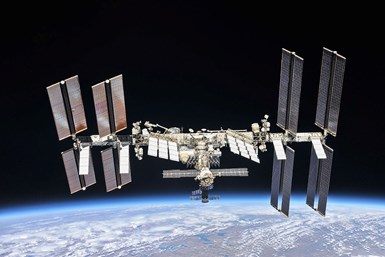AddUp Is Helping Bring Metal 3D Printing to Space
To make additive manufacturing in microgravity possible, the group has chosen to use a process that promotes forces induced by surface tension — wire-laser combination (W-DED).

AddUp is helping create a 3D printer that will produce the first metal parts in space in the International Space Station. Photo Credit: NASA/Roscosmos
AddUp is part of a “Metal3D” group project which is working to create a 3D printer to produce the first metal parts in space made via additive manufacturing (AM). The project is led by the European Space Agency (ESA), Airbus Defense and Space, and other industrial and academic partners such as Highftech Engineering and Cranfield University.
For the first time in history, a custom-made AM machine will be installed on board the International Space Station (ISS) within the Columbus module and be the first of its kind to be able to print in space.
This large-scale project involves several entities, including the ESA which commands the mission. Project management is provided by the Airbus Defense and Space teams in Toulouse. Their teams ensure the integration of the various components of the printer, power supply and conformity for the space environment. Cranfield University oversees the energy source and material delivery mechanism. In the case of metal 3D, this includes a laser and stainless-steel wire. The company Highftech is tasked with the manufacturing of the machine enclosure and integrating the machine’s fluid management. Finally, AddUp makes the internal structure and mechanisms of the machine, the PLC that controls it and the interface that enables communication with the ground.
“AddUp plays an important role in the realization of this mission, but its involvement in the project goes back to the preproject phase where the feasibility of the project had to be demonstrated,” says Alexandre Piaget, AddUp R&D engineer. “This first part, carried out on the premises in Salon de Provence, built the foundations of what the machine is today. In the final version of the machine, AddUp is in charge of the mobile axes, the structural parts and the software of the machine.”
On the mechanical side, AddUp’s team designed and manufactured the internal structure of the machine, including all moving parts. On the software side, they developed the machine’s automation program, which includes functions such as communication with the ground (sending of data, measurements, images and reports, and execution of commands received from Earth).
Metal3D is commissioned by the ESA as a technology demonstrator. The purpose is to characterize the mechanical properties of a material shaped in microgravity. To carry out this experiment, two batches of test specimens will be produced by two identical printers. While the first batch will be made in Toulouse in terrestrial gravity, the second will be built in space, within the Columbus module of the ISS in microgravity. To produce these two printing projects, two identical copies of a metal 3D printing machine capable of operating in both environments have been designed and produced.
The project challenge is production under microgravity. In the absence of gravity, most current AM processes are not usable. This is either because they are not compatible with the space environment (the use of fine powder is dangerous in the space station) or because their implementation is conflicting with microgravity (for example powder bed technologies).
To make manufacturing in microgravity possible, the partners have chosen to use a process that promotes forces induced by surface tension: this is the wire-laser combination (W-DED). A laser will be used as the energy source and a 316L stainless steel wire as the raw material. The laser and the wire feeding system are fixed in the machine frame and the printing table is made movable by three linear axes and one rotary axis. The machine is operated under nitrogen to limit the oxidation of the material and prevent the risk of combustion. As access to nitrogen is limited in the ISS, the machine’s atmosphere is filtered and cooled throughout the manufacturing process to limit nitrogen consumption and recycle as much as possible of the nitrogen already present in the machine.
Related Content
3D Printed Titanium Replaces Aluminum for Unmanned Aircraft Wing Splice: The Cool Parts Show #72
Rapid Plasma Deposition produces the near-net-shape preform for a newly designed wing splice for remotely piloted aircraft from General Atomics. The Cool Parts Show visits Norsk Titanium, where this part is made.
Read More“Mantis” AM System for Spacecraft Uses Induction for Deposition
The metal 3D printing system melts wire without lasers. 30-foot-diameter parts are built on a rotary-feed system that eliminates the need for a large machine frame or gantry.
Read MoreAdditive Manufacturing Is Subtractive, Too: How CNC Machining Integrates With AM (Includes Video)
For Keselowski Advanced Manufacturing, succeeding with laser powder bed fusion as a production process means developing a machine shop that is responsive to, and moves at the pacing of, metal 3D printing.
Read More3D Printed Lattice for Mars Sample Return Crash Landing: The Cool Parts Show Bonus
NASA Jet Propulsion Laboratory employs laser powder bed fusion additive manufacturing plus chemical etching to create strong, lightweight lattice structures optimized to protect rock samples from Mars during their violent arrival on earth.
Read MoreRead Next
Bike Manufacturer Uses Additive Manufacturing to Create Lighter, More Complex, Customized Parts
Titanium bike frame manufacturer Hanglun Technology mixes precision casting with 3D printing to create bikes that offer increased speed and reduced turbulence during long-distance rides, offering a smoother, faster and more efficient cycling experience.
Read MorePostprocessing Steps and Costs for Metal 3D Printing
When your metal part is done 3D printing, you just pull it out of the machine and start using it, right? Not exactly.
Read More3D Printed Polymer EOAT Increases Safety of Cobots
Contract manufacturer Anubis 3D applies polymer 3D printing processes to manufacture cobot tooling that is lightweight, smooth and safer for human interaction.
Read More



















